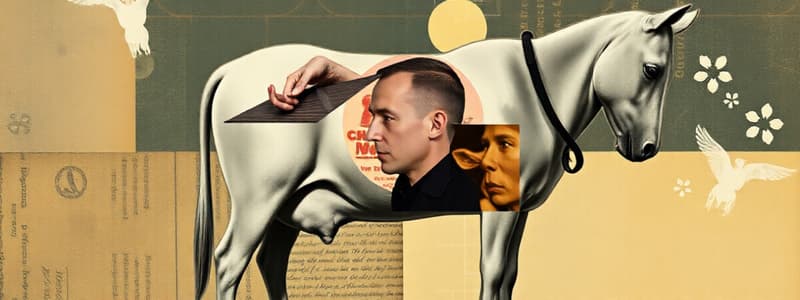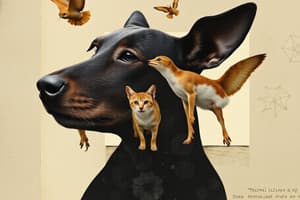Podcast
Questions and Answers
What is one of the key factors influencing animal welfare according to the five domains model?
What is one of the key factors influencing animal welfare according to the five domains model?
- Cultural traditions in animal care
- Marketing strategies for animal products
- Public support for animal practices (correct)
- Historical treatment methods
How does the five domains model of animal welfare primarily assess well-being?
How does the five domains model of animal welfare primarily assess well-being?
- Through public perception surveys
- By looking at behavior and physiology (correct)
- Through financial performance of animal industries
- By evaluating animal health only
Which statement best differentiates animal welfare from animal well-being?
Which statement best differentiates animal welfare from animal well-being?
- Animal welfare is only concerned with physical health.
- Animal well-being focuses on financial profitability.
- Animal well-being is only about public perception.
- Animal welfare includes both physical and mental aspects. (correct)
What complicates the veterinarian's role in animal welfare?
What complicates the veterinarian's role in animal welfare?
What can inadvertently create welfare issues despite good intentions?
What can inadvertently create welfare issues despite good intentions?
Which of the following is NOT typically included in animal welfare assessments?
Which of the following is NOT typically included in animal welfare assessments?
What role do veterinarians traditionally fill in animal welfare?
What role do veterinarians traditionally fill in animal welfare?
Which factor is NOT a part of the assessment of animal welfare?
Which factor is NOT a part of the assessment of animal welfare?
What does the Five Freedoms model assess in terms of animal welfare?
What does the Five Freedoms model assess in terms of animal welfare?
In the context of animal welfare, what is the main focus of the 'feelings approach'?
In the context of animal welfare, what is the main focus of the 'feelings approach'?
How does animal well-being differ from animal welfare?
How does animal well-being differ from animal welfare?
What does the OIE definition of animal welfare emphasize?
What does the OIE definition of animal welfare emphasize?
Which of the following is NOT one of the Five Freedoms as it relates to animal welfare?
Which of the following is NOT one of the Five Freedoms as it relates to animal welfare?
What aspect of animal welfare is primarily linked to an animal's ability to express natural behavior?
What aspect of animal welfare is primarily linked to an animal's ability to express natural behavior?
Which statement about animal welfare assessments is accurate?
Which statement about animal welfare assessments is accurate?
What is a common misconception about animal welfare?
What is a common misconception about animal welfare?
Which option is not one of the Five Freedoms of Animal Welfare?
Which option is not one of the Five Freedoms of Animal Welfare?
Which statement best differentiates animal welfare from animal well-being?
Which statement best differentiates animal welfare from animal well-being?
What is implied by the statement that poor welfare may make disease more likely?
What is implied by the statement that poor welfare may make disease more likely?
How does Broom define animal welfare?
How does Broom define animal welfare?
What limitation should be considered when interpreting productivity as a measure of animal well-being?
What limitation should be considered when interpreting productivity as a measure of animal well-being?
According to the Five Freedoms, how should animal comfort be addressed?
According to the Five Freedoms, how should animal comfort be addressed?
What does the concept of animal welfare imply regarding disease?
What does the concept of animal welfare imply regarding disease?
What aspect of welfare is highlighted by Duncan's definition?
What aspect of welfare is highlighted by Duncan's definition?
What does the term 'pathogenesis' refer to in veterinary pathology?
What does the term 'pathogenesis' refer to in veterinary pathology?
Which division of pathology focuses on examining blood and tissue changes to identify diseases?
Which division of pathology focuses on examining blood and tissue changes to identify diseases?
What distinguishes necropsy from an autopsy?
What distinguishes necropsy from an autopsy?
Who is commonly referred to as the father of modern pathology?
Who is commonly referred to as the father of modern pathology?
What is the primary focus of an anatomic pathologist in veterinary medicine?
What is the primary focus of an anatomic pathologist in veterinary medicine?
Which technique is commonly used in pathology to observe detailed tissue structure?
Which technique is commonly used in pathology to observe detailed tissue structure?
What does 'morbidity' refer to in veterinary pathology?
What does 'morbidity' refer to in veterinary pathology?
What role does pathology play in veterinary medicine?
What role does pathology play in veterinary medicine?
Flashcards are hidden until you start studying
Study Notes
Animal Welfare - Definitions and Concepts
- Animal welfare refers to the state of the animal, encompassing its physical and mental well-being.
- Animal care, husbandry, and humane treatment are separate terms that relate to the specific treatment an animal receives.
- Five Domains Model is used to assess animal welfare, considering:
- Science: Animal behavior and physiology.
- Economic feasibility: Sustainability for the animal industry.
- Social license: Public acceptance of practices.
- Traditionally, veterinarians focused on treating injuries, diseases, and providing pain control. Their role has expanded to include advising on housing, handling, nutrition, and advocating for humane care.
- Veterinarians have been criticized for supporting problematic housing systems, painful procedures, and being reluctant to adapt traditional practices, though their intention is to improve animal health.
- Productivity is not always a reliable indicator of animal welfare, as economic measures may not reflect true well-being.
- Brambell's definition of welfare: Emphasizes both physical and mental well-being, considering the animal's feelings as derived from its structure, functions, and behavior.
- Five Freedoms (1993):
- Freedom from thirst and hunger.
- Freedom from discomfort.
- Freedom from pain, injury, and disease.
- Freedom to express normal behavior.
- Freedom from fear and distress.
- Different definitions of animal welfare:
- Duncan: Emphasizes how an animal feels.
- Moberg: Focuses on pre-pathological state.
- Broom: Emphasizes an animal's coping mechanisms with its environment.
- Curtis: Emphasizes productivity and reproductive performance.
- OIE: Defines animal welfare as the animal's ability to cope with its environment, encompassing health, comfort, nourishment, safety, and ability to express natural behavior.
- Broom's definition of animal welfare: Animal welfare is the state of an individual as it attempts to cope with its environment.
- The Welfare Continuum: This concept suggests that an animal's welfare exists on a scale from good to poor. Different aspects of the Five Freedoms may be at different levels on this continuum.
- Duncan's definition of animal welfare: Welfare is largely dependent on what animals feel.
- Animal well-being: Often used interchangeably with animal welfare, with a stronger emphasis on subjective feelings.
- Schools of thought in animal welfare science:
- Biological functioning: Focuses on an animal's ability to cope with its environment.
- Feelings approach: Focuses on how an animal feels about its environment.
- Nature approach: Focuses on an animal's ability to display natural behavior in its environment.
- OIE definition of animal welfare: "Animal welfare means how an animal is coping with the conditions in which it lives. An animal is in a good state of welfare if (as indicated by scientific evidence) it is healthy, comfortable, well nourished, safe, able to express innate behaviour, and if it is not suffering from unpleasant states such as pain, fear, and distress."
- Good animal welfare requires: Disease prevention, appropriate veterinary treatment, shelter, management and nutrition, humane handling, and humane slaughter or killing.
Definitions
- Pathology: The study of disease
- Logos: The study of reason, divine wisdom
- Morbidity: Diseased state, ill health
- Mortality: Death
- Pathogenesis: The mechanism of a sequence of events from a stimulus that leads to disease
Veterinary Pathology
- A bridging discipline between basic sciences (physiology, microbiology, anatomy, molecular biology) and clinical sciences (surgery, medicine, dermatology)
- Examines the relationship between changes in structure and function of cells, tissues, and organs.
- Underpins every aspect of patient care - provides information from diagnosis to treatment.
Divisions of Veterinary Pathology
- Anatomic pathologist: Examines morphological (structural) changes in tissues and organs to identify the cause of disease
- Clinical pathologist: Examines changes in blood (hematology and serum chemistry) and tissue biopsy (cytology) to help identify the cause of disease
Pathology: Diagnostics
- Post-mortem: Autopsy (people), necropsy (animals). Common diagnostic technique
- Light Microscopy: Histology and cytology. Common diagnostic technique. Light magnification is used to observe detailed tissue structure. Various stains help identify and differentiate tissue structures.
Resolution
- The ability to distinguish between two closely situated objects.
Studying That Suits You
Use AI to generate personalized quizzes and flashcards to suit your learning preferences.



